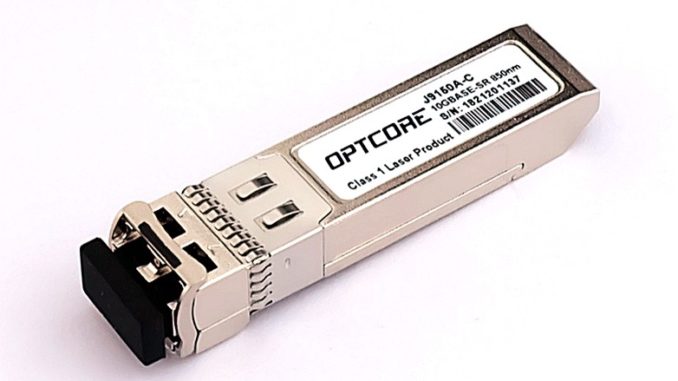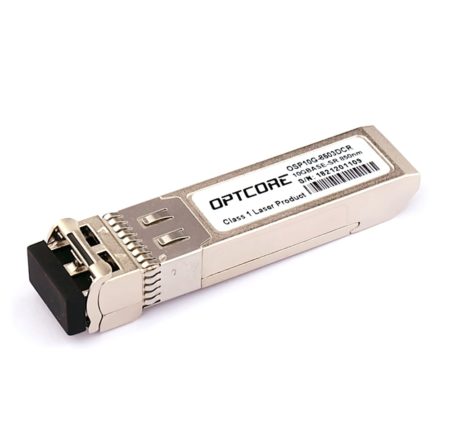
The SFP+ optical module is a mainstream enhanced hot-swappable optical module that connects the device board to other devices and has a data rate of 10G. So how do you use SFP+ optical modules correctly? In addition to choosing the right model, you need to know how to install and remove the SFP+ optical module. In this article, we will show how to select, install, remove optical modules, as well as common usage tips. In order to help you use SFP+ optical modules more correctly.
1. Select the correct SFP+ optical module
Before installing an SFP+ optical module, you must select the appropriate optical module. So how do you choose the right SFP+ optical module? There are two main points, as follows:
(1) Determine the required transmission distance
SFP+ optical modules have different transmission distances of 300m, 10km, 40km, 80km, etc. You can select the appropriate SFP+ optical module according to the actual application.
(2) Determine the wavelength limit or requirement
Different types of SFP+ optical modules can meet different wavelength requirements, and generally have a label on the top, bottom or side of the SFP+ optical module. The label will explain the basic information of this optical module so that you can identify and select the appropriate optical module. For example, the picture of the Cisco compatible SFP-10G-SR SFP+ optical module is shown below. It can be seen from the label that it is an SFP+ optical module with a wavelength of 850 nm.
2. Install SFP+ optical module
(1) The steps for installing an SFP+ optical module are as follows:
• Remove the SFP+ optical module from the protective packaging;
• Hold the SFP+ light module between the thumb and forefinger;
• Insert the SFP+ optical module into the SFP+ slot of the switch and apply slight pressure to the SFP+ optical module until the device clicks and locks into place. If the SFP+ is resistant to pressure, do not force it to be applied, flip it over and reinsert it into the SFP+ slot;
• Remove the dust cover from the SFP+ hole and insert the fiber optic cable.
(2) Precautions for installing SFP+ optical modules:
• The data rate of the SFP+ optical module and the XFP optical module is 10G, but it is not compatible with the same device. Therefore, do not install the SFP+ optical module in the XFP slot. Make sure that the slot is an SFP+ slot before installation.
• SFP+ optical modules and SFP optical modules have similar appearances, but their data rates and functions are different, so do not install SFP+ optical modules in SFP slots. You must ensure your switches and SFP+ before installing or using SFP+ optical modules. Optical modules are compatible with each other;
• Check if the SFP+ optical module is the correct model of the network configuration;
• Before installing an SFP+ optical module, make sure it is clean and has not received any contamination;
• Fiber optic equipment can emit laser or infrared light that can damage the eyes, so don’t look at the ports of the fiber or connector. You can assume that the fiber optic cable is connected to the light source;
• To prevent damage from electrostatic discharge, always wear an antistatic wrist strap;
• Only trained personnel should install this product;
• It takes about three minutes to install the SFP+ optical module.
3. Remove the SFP+ optical module
The steps to remove an SFP+ optical module are as follows:
(1) Disconnect the optical fiber from the SFP+ optical module;
(2) attach the dust cover to the fiber hole and the connector;
(3) slide the latch handle down and use it to extract the SFP+ optical module;
(4) Pull out the SFP+ optical module. If the SFP+ optical module cannot slide out easily from the slot, use the side swing motion and pull the SFP+ optical module out of the slot.
(5) Store the SFP+ optical module in a safe place and wait until the next time you need it.
Tips for using SFP+ optical modules
1. Multimode optical modules cannot be transmitted on single-mode fibers. The main reason for the transmission distance is that the attenuation of multimode optical fibers is too large;
2. The transmission of a single-mode optical module over 10km on multimode fiber needs to be noted that the optical power at the receiving end cannot exceed the saturated optical power value, otherwise the receiving device may be damaged; this problem should also be noted on single-mode fiber; Try to receive the optical power on the receiving side before connecting to determine if it can be connected. If the optical power is too strong, consider using an appropriate attenuator to add additional attenuation to meet the connection requirements;
3. 10km single-mode SFP+ optical module can support transmission on multimode fiber. The transmission distance and the corresponding multimode SFP+ optical module are the same on the multimode fiber. The key influence of the transmission distance is not attenuation but dispersion;
4. The SFP+ optical module has ceramic components inside. Take care when handling the SFP+ optical module. If it is accidentally dropped or bumped, the SFP+ optical module is not recommended to be used again to avoid subsequent failures.
5. When inserting the optical fiber cable into the SFP+ optical module, it is required to be gentle and inserted directly into the optical port. If the force is too strong or obliquely inserted, the SFP+ optical module may be damaged.
6. The optical port of the SFP+ optical module cannot be exposed for a long time. If it is not used for a long time, it needs to be equipped with a dust cover for curing;
7. Most SFP+ optical module indicators support hot swap, but it is not recommended for frequent hot swap, which may cause electrical damage.
8. Check the operation specifications of the SFP+ optical module:
- When the optical module is removed, do not touch the gold finger of the SFP optical module to avoid damage to the SFP+ optical module.
- When inserting the SFP optical module, confirm the SFP+ optical module. The handle is attached to the optical port of the SFP+ optical module and then inserted. If the SFP+ optical module has just been removed, do not unplug the optical port and insert it directly.
- When unplugging the SFP+ optical module, first pull out the optical fiber cable, pull it slowly to the optical port and then slowly pull it out. If you pull it out, you can’t pull it too hard or pull it out. It may be The SFP+ optical module shield is damaged.
Conclusion
Care must be taken when handling SFP+ optical modules, especially to avoid damage to the eyes caused by laser or infrared light emitted by fiber optic equipment. In addition, we offer a variety of SFP+ optical module options, and all of our SFP+ optical modules are 100% compatible with major brands such as Cisco, Huawei, Juniper, HPE, and can also provide customized services to meet your needs. Install our optical modules and believe that your network speed and density will be greatly improved.